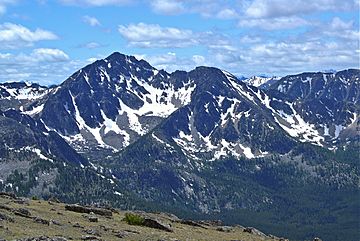Remmel Mountain facts for kids
Quick facts for kids Remmel Mountain |
|
|---|---|

Remmel Mountain seen from Apex Mountain
|
|
| Highest point | |
| Elevation | 8,690 ft (2,650 m) |
| Prominence | 4,365 ft (1,330 m) |
| Parent peak | Mount Lago |
| Listing | Washington prominent peaks 25th Washington highest peaks 35th |
| Geography | |
| Location |
|
| Parent range | Cathedral Range Okanogan Range North Cascades Cascade Range |
| Topo map | USGS Remmel Mountain |
| Type of rock | Granite |
| Climbing | |
| First ascent | 1904 by Sledge Tatum and George E. Louden, Jr. |
| Easiest route | Hiking trail via Southeast slope |
Remmel Mountain, also known as Mount Remmel, is a tall mountain peak. It stands 8,690 feet (2,649 meters) high. You can find it in Okanogan County, Washington state.
This mountain is the highest point in the Cathedral Range. The Cathedral Range is part of the larger Okanogan Range in the North Cascades. Remmel Mountain is about 5 miles (8 km) south of the border with Canada. It sits on the eastern side of the Cascade Mountains. The mountain is located within the Pasayten Wilderness, on land managed by the Okanogan National Forest.
The closest taller peak is Mount Lago, about 16.8 miles (27 km) to the west-southwest. Amphitheater Mountain is 3.6 miles (5.8 km) north. Remmel Mountain is the third-highest peak in the Okanogan Range. It is also the most prominent mountain in the Pasayten Wilderness. Water flowing from Remmel Mountain eventually drains into the Chewuch River.
Mountain History
The peak was named in 1898 by Albert Hale Sylvester. He was a pioneer surveyor and explorer. He also worked as a forest supervisor in the Cascades. Sylvester named thousands of natural places in the area.
The first ascent (first time someone successfully climbed to the top) of Remmel Mountain happened on July 26, 1904. Sledge Tatum and George E. Louden, Jr. were the first to reach the summit. They were part of a group called the Boundary Survey.
Remmel Mountain once had a fire lookout building on its top. The Forest Service built this 14-foot by 14-foot building in the 1930s. It had a special roof to help protect it. However, the lookout was often hit by lightning. Because of this, it was closed down. By 1969, reports said the building was destroyed.
Mountain Geology
The North Cascades mountains have very rugged land. You can see craggy peaks, tall granite spires, ridges, and deep glacial valleys. Geological events that happened millions of years ago created this diverse landscape. These events also caused the big changes in elevation across the Cascade Range. This led to different climates in different areas.
The Cascade Mountains started forming millions of years ago. This was during the late Eocene Epoch. The North American Plate was moving over the Pacific Plate. This caused many volcanic eruptions. Also, small pieces of the Earth's crust, called terranes, came together. This helped create the North Cascades about 50 million years ago.
During the Pleistocene period, which was over two million years ago, glaciers moved across the land many times. As they moved, they scraped and shaped the landscape. They left behind piles of rock debris. The river valleys in the area have a "U"-shape. This shape is a result of these recent glaciers. The rising of the land and faults, along with glaciation, have been the main forces. They created the tall peaks and deep valleys you see in the North Cascades today.
Mountain Climate
Most weather fronts start in the Pacific Ocean. They then travel northeast towards the Cascade Mountains. As these weather fronts get close to the North Cascades, the tall peaks force them upward. This causes the air to cool and drop its moisture. This moisture falls as rain or snowfall onto the Cascades. This process is called Orographic lift.
Because of this, the west side of the North Cascades gets more rain and snow than the east side. This is especially true during the winter months. In winter, the weather is usually cloudy. But in summer, high-pressure systems over the Pacific Ocean become stronger. This often means there is little or no cloud cover during the summer.
Images for kids








